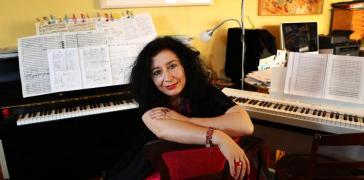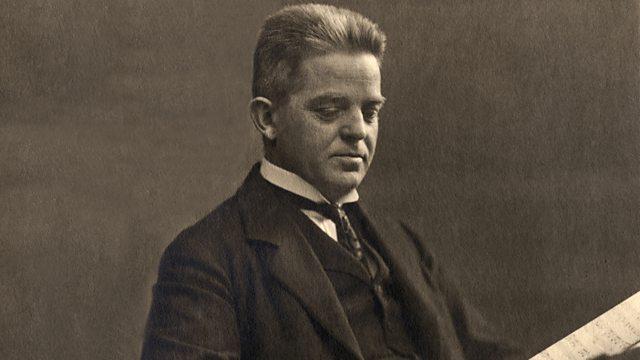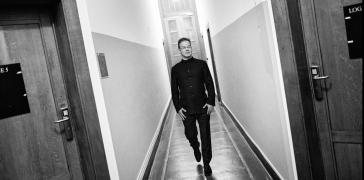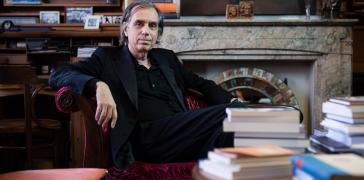
Carl Nielsen - an Unclassifiable and Astonishingly Stubborn Dane

"Music from another planet" is how the symphonic works of Danish composer Carl Nielsen (1865-1931) is sometimes described. A work that seems to have been influenced on many levels by Beethoven's Fifth, as evidenced by the rhythmic articulation and orchestral translation of struggle and conflict. Nor is it by chance that his Symphony No. 3, Op. 27, known as the "Sinfonia espansiva", opens with a pulsating motif, which Nielsen follows with a grandiose, expansive theme to plunge the listener straight into the heart of the battle. This is a superb symphony, with glimpses of his country's horizon, a score whose premiere in 1912 won over audiences across Europe.
The small village of Nørre Lyndelse nestles in the heart of the Danish island of Fyn, more precisely to the south of Odense. This is where Carl Nielsen grew up, surrounded by the traditional music of the Danish countryside. Naturally gifted for music, he took violin and piano lessons from an early age and composed his first pieces when he was eight or nine. At fourteen, he became a bugler and trombonist in a battalion stationed in Odense, while continuing to play the violin.
Danish musical identity
The Danish court and concert halls were very fond of German and Italian music from the fifteenth century onwards. There were, of course, Danish composers, even if a composer like Dietrich Buxtehude (1637-1707) was above all a representative of the baroque style of the North German school. At the same time, Denmark's history was enriched by a vast heritage of legends and traditional songs, which composers began to take an interest in in the eighteenth century. This gave rise to the 'syngespil' (a theatrical work performed and sung), a genre of musical theatre that is authentically Danish.
These politically troubled times encouraged musical nationalism throughout Europe. The Italians found "their" music in Verdi, the Poles in Chopin, the Czechs in Smetana... Wagner and Weber's opera Der Freischütz (1821) were to accompany the unification of Germany. For the Danes, there was no great composer but Elverhøj ("the hill of the elves"), a "syngespil" composed in 1828 by Friedrich Kuhlau, which contains many Scandinavian songs.
Denmark experienced a new wave of nationalism during the wars to conquer the duchies of Schleswig-Holstein - and especially after the terrible defeat by Germany in 1864. Romantic music inspired by Nordic epics and traditional local tales was in its heyday, as were the "Nordic" sounds of simple melodies with popular accents, characterised by a calm rhythm and passages in the minor mode carried by sombre orchestration.
Symphony No. 3, "Sinfonia espansiva"
In 1889, the young Nielsen, just out of the conservatory, joined the Royal Danish Orchestra, a godsend for his career as a composer. He developed an obstinate style, full of urgent rhythms and tonal liberties, which did not immediately win him over in his homeland. It was not until 1912 and the premieres of his Symphony No. 3, a very melodious symphony, and the Violin Concerto Op. 33, a virtuoso piece, that audiences and critics were finally won over.
Nielsen's symphonic work contains few typically Danish elements. It is mostly energetic, extremely rhythmic and harmonically nervous. Traditional tales and Nordic melodies are absent. Very rarely does a score conjure up pastoral landscapes in chiaroscuro, as in the second movement of Symphony No. 3 (1912). But Nielsen does not see this as a nationalistic impulse.
The Symphony No. 3, Op. 27, "Sinfonia espansiva" is characterised by structural clarity and a concise Haydn-like four-movement structure. The score opens with a pulsating motif in an ever-accelerating tempo (Allegro espansivo), followed by a grandiose, expansive theme to plunge the listener straight into the heart of the battle. Like Jean Sibelius in his symphonies, however, he tempers the Romantic pathos and heroism. After the expansive urgency of the first movement, Nielsen inserts a pastorale (Andante pastorale): idyllic melodies heightened by bursts of passion. Towards the end of the second movement, two wordless vocalises (soprano solo and baritone solo) blend into the orchestral palette. The atmosphere is serene and peaceful, that of nature before the fall. The intermezzo that follows (Allegretto un poco) once again demonstrates the Dane's predilection for string solos. The symphonic work ends with a liberating finale (Finale. Allegro) on a hymnal theme. There is nothing here to suggest the shadows and despair characteristic of Nielsen's later symphonies. The premiere on 28 February 1912 - with that of the Violin Concerto, Op. 33 - was acclaimed. This two-movement concerto is reminiscent of the Baroque concerto grosso, which distinguishes it from Jean Sibelius's Violin Concerto, Op. 74 (in three movements, with a much more prominent orchestral part), which was very much in vogue at the time.
The Symphony No. 4, “The Inextinguishable”, composed in 1916, was to appeal to an even wider audience. There is no trace of the gentle romanticism of Gade, Grieg and other Scandinavian composers. Against the backdrop of the First World War, Nielsen has written a powerful universal plea for humanity, culminating in a dramatic climax with a duel between two timpani.
A national symbol against all odds
In his symphonic music, Nielsen has followed a resolutely personal path, far removed from folklore. The fact that he is still regarded as a national symbol, and his music as typically Danish, is due to the influence of nineteenth-century discourse, which continued to "pigeonhole" composers long after the Second World War. Nielsen's highly personal style has become the music of Denmark because young Danish composers have seized upon it. His symphonic style and sound came to be associated with Scandinavia, as his works had a profound influence on many Scandinavian composers of the first half of the twentieth century. The Nordic characteristics of his music are partly a matter of categorisation or a posteriori construction. In this way, he became a seminal figure, albeit unwillingly.
By Johan Van Acker


